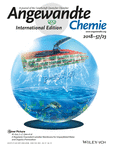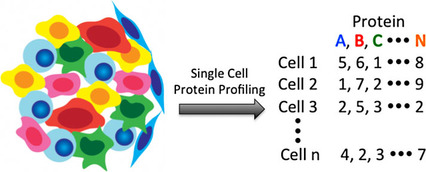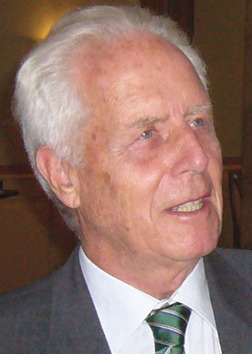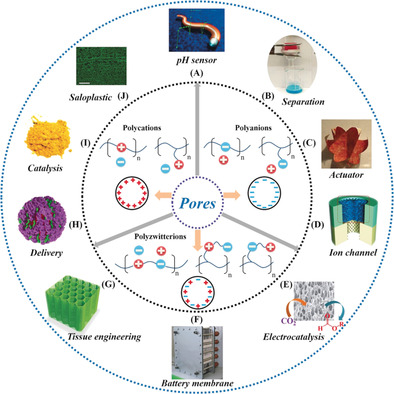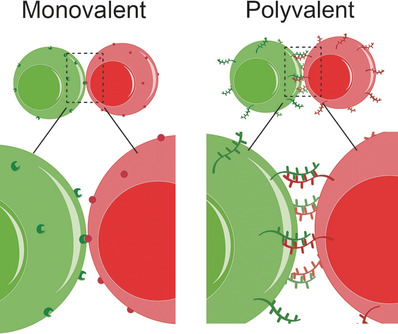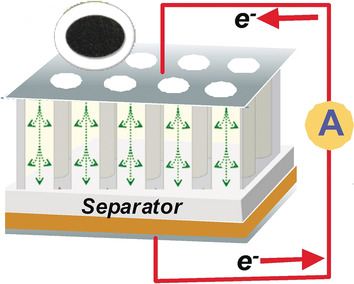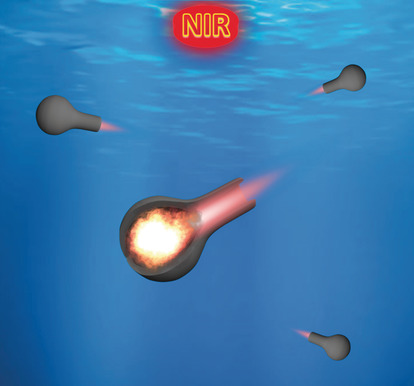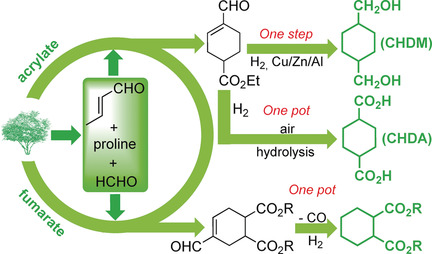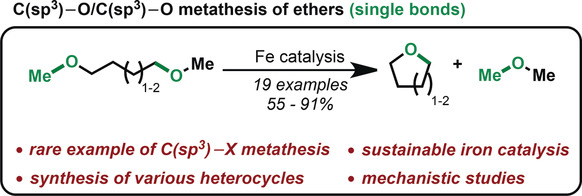Journal list menu
Export Citations
Download PDFs
Cover Pictures
Cover Picture: A Regularly Channeled Lamellar Membrane for Unparalleled Water and Organics Permeation (Angew. Chem. Int. Ed. 23/2018)
- Page: 6707
- First Published: 16 April 2018
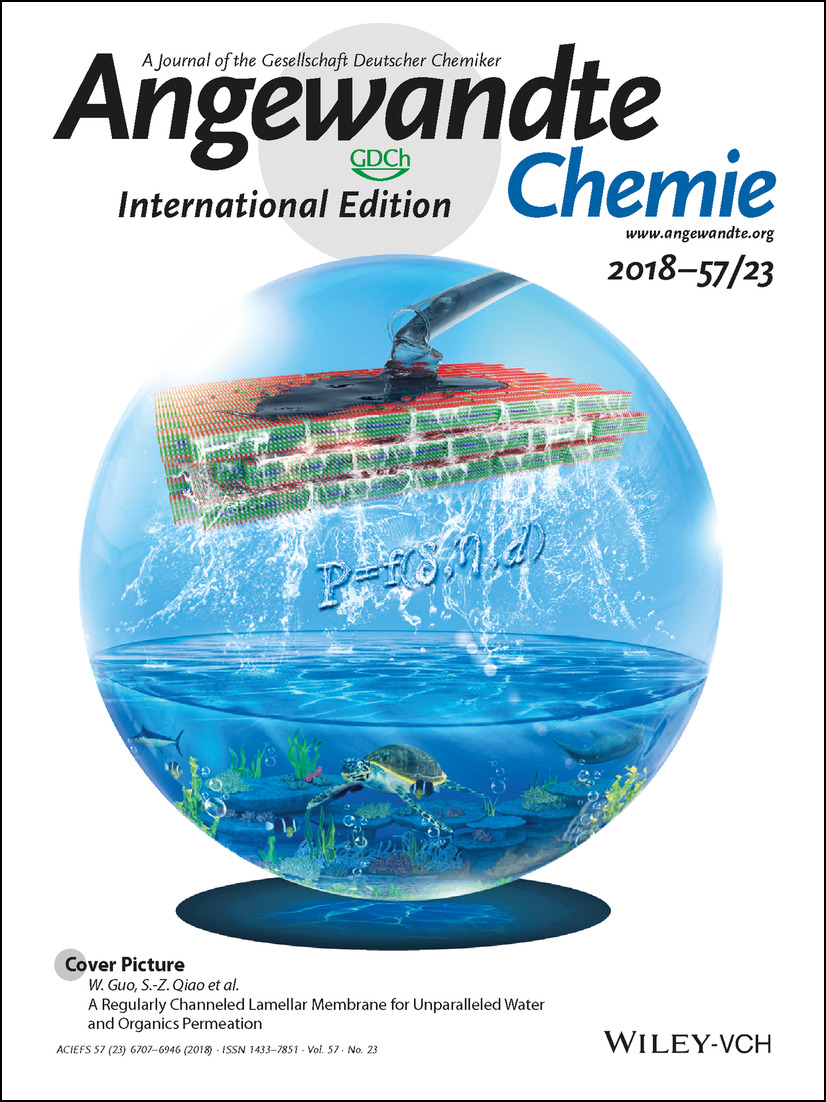
Lamellar membranes with ordered interlayer channels show exceptional permeation properties for separation processes. In their Communication on page 6814 ff., W. Guo, S.-Z. Qiao et al. demonstrate the direct self-stacking of rigid MXene nanosheets to form highly regular and straight 2 nm channels. The membranes exhibit unparalleled permeation of liquids from water to organics and achieve precise molecular rejection of targeted dyes. Significantly, the equation for the molecular transfer rate in confined channels is also established.
Inside Cover: Polyvalent Display of Biomolecules on Live Cells (Angew. Chem. Int. Ed. 23/2018)
- Page: 6708
- First Published: 14 April 2018

Supramolecular engineering of cell surfaces was explored as a means to display polyvalent biomolecules on live cells using branched DNA polymers. In their Communication on page 6800 ff., Y. Wang et al. show that by using polyvalent surface display of biomolecules, the ability of engineered cells to recognize the microenvironment can be enhanced by at least an order of magnitude.
Inside Back Cover: Silica-Protection-Assisted Encapsulation of Cu2O Nanocubes into a Metal–Organic Framework (ZIF-8) To Provide a Composite Catalyst (Angew. Chem. Int. Ed. 23/2018)
- Page: 6945
- First Published: 17 April 2018
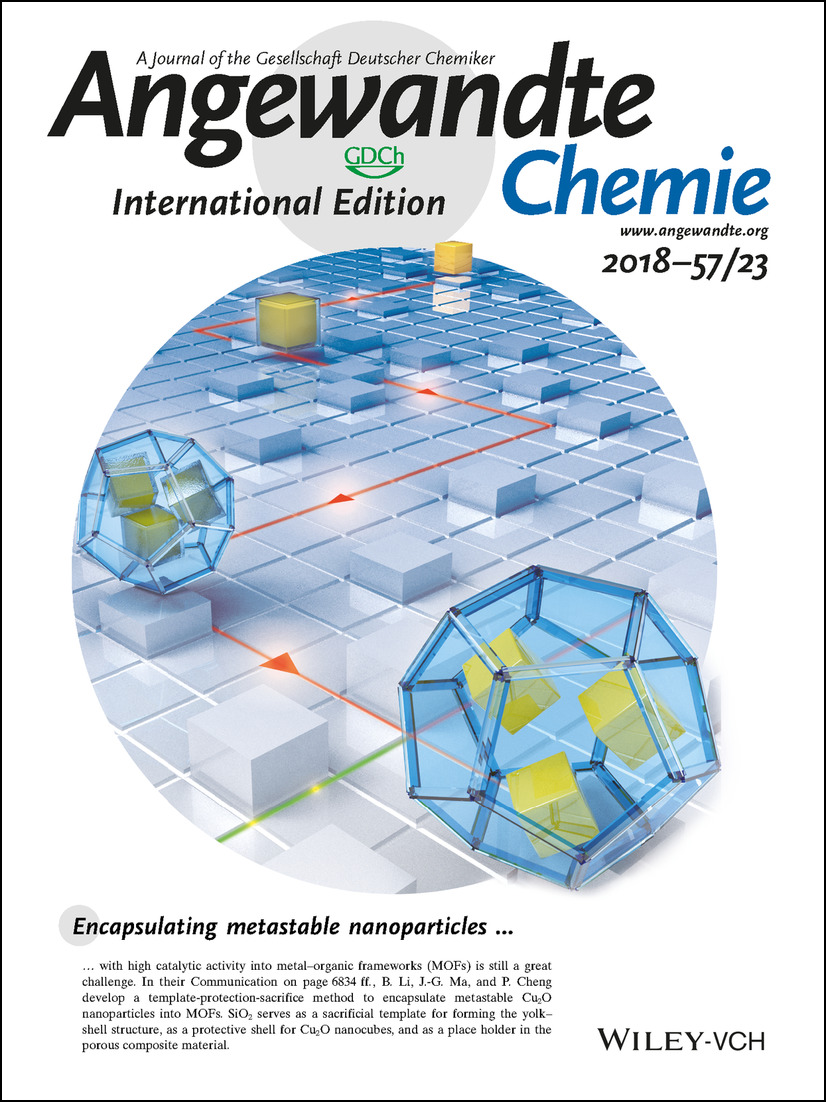
Encapsulating metastable nanoparticles with high catalytic activity into metal–organic frameworks (MOFs) is still a great challenge. In their Communication on page 6834 ff., B. Li, J.-G. Ma, and P. Cheng develop a template-protection-sacrifice method to encapsulate metastable Cu2O nanoparticles into MOFs. SiO2 serves as a sacrificial template for forming the yolk–shell structure, as a protective shell for Cu2O nanocubes, and as a place holder in the porous composite material.
Back Cover: Porous Polyelectrolytes: The Interplay of Charge and Pores for New Functionalities (Angew. Chem. Int. Ed. 23/2018)
- Page: 6946
- First Published: 14 April 2018

Porous polyelectrolytes are multifunctional platforms that enable the design and creation of multiscale polymer structures with tailored and adaptive properties. In their Review on Page 6754 ff., W. Zhang, Q. Zhao, and J. Yuan show that porous polyelectrolytes with diverse structures including membranes, particles, scaffolds, and high surface area powders/resins can be formed by a plethora of fabrication methods for applications ranging from energy conversion, nanomedicine.
Frontispiece
Frontispiece: Synthesis of a Helical Bilayer Nanographene
- First Published: 25 May 2018

Graphene Chemistry An inherently chiral bilayer nanographene with a helicene linker has been synthesized as the racemate and the M isomer with 93 % ee by N. Martín et al. in their Communication on page 6774 ff.
Editorial
Editorial: The Energy Challenge, Batteries, and Why Simple Math Matters
- Pages: 6710-6711
- First Published: 25 April 2018

“Despite the great progress we have seen in the last 20 years, we are still far from having a sustainable energy supply … When discussing the Energiewende, the relevant numbers are so large that they are hard to realize. How can we understand the dimension of the Energiewende in a more concrete way? …”. Read more in the Editorial by Philipp Adelhelm.
Graphical Abstract
Graphical Abstract: Angew. Chem. Int. Ed. 23/2018
- Pages: 6713-6725
- First Published: 25 May 2018
News
Spotlights on our sister journals: Angew. Chem. Int. Ed. 23/2018
- Pages: 6728-6731
- First Published: 25 May 2018
Author Profile
News
Robert Foster Cherry Award: N. K. Garg / Innovation Prize in Medicinal/Pharmaceutical Chemistry: F. K. Hansen and A. Titz
- Page: 6734
- First Published: 09 May 2018
Obituary
Highlights
Nitrogen Fixation
Metal-Free Nitrogen Fixation at Boron
- Pages: 6738-6740
- First Published: 02 May 2018
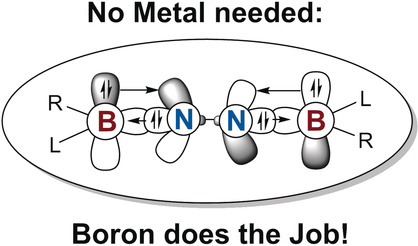
No metal needed: Boron does the job! The activation of the inert dinitrogen molecule has fascinated chemists for ages. In a ground-breaking study Braunschweig and co-workers have now demonstrated that N2 activation can be achieved with the aid of the p-block element boron—a reactivity previously restricted to transition metals.
Minireviews
NMR Spectroscopy
Signal Amplification by Reversible Exchange (SABRE): From Discovery to Diagnosis
- Pages: 6742-6753
- First Published: 06 January 2018
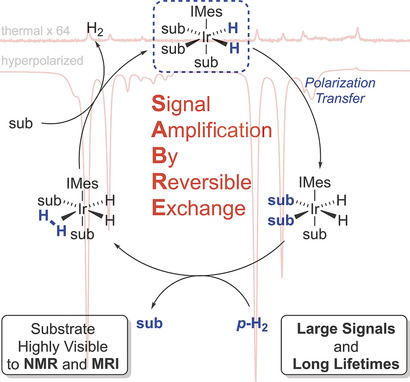
SABRE-rattling: Signal amplification by reversible exchange (SABRE) is a hyperpolarization technique that dramatically enhances magnetic resonance signals. This Minireview tracks its development since its discovery in 2009 and offers an outlook on its potential use for both analytic sciences and disease diagnosis.
Reviews
Polyelectrolytes
Porous Polyelectrolytes: The Interplay of Charge and Pores for New Functionalities
- Pages: 6754-6773
- First Published: 09 November 2017
Communications
Nanographene
Synthesis of a Helical Bilayer Nanographene
- Pages: 6774-6779
- First Published: 15 February 2018

A twist of graphene: An inherently chiral bilayer nanographene with a helicene linker has been synthesized as the racemate and the M isomer with 93 % ee. This first member of a new family of twisted double-layer polyaromatic hydrocarbons is characterized, and its electrochemical and photophysical properties explored.
Biosynthesis
In Vitro Biosynthesis of the Nonproteinogenic Amino Acid Methoxyvinylglycine
- Pages: 6780-6785
- First Published: 06 April 2018
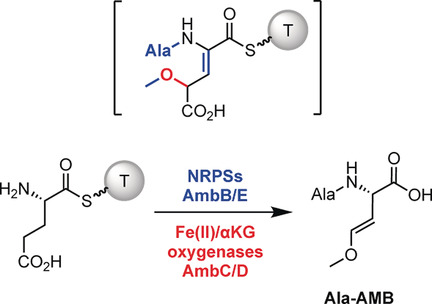
The in vitro biosynthesis of an oxyvinylglycine is reported for l-2-amino-4-methoxy-trans-3-butenoic acid (AMB). AMB is synthesized from glutamate as an alanyl-AMB dipeptide. Crafting the AMB vinyl ether requires a cascade of modifications, including a cryptic hydroxylation and a likely 2,3-dehydration.
Stimuli-Responsive Materials
Reversible Response of Luminescent Terbium(III)–Nanocellulose Hydrogels to Anions for Latent Fingerprint Detection and Encryption
- Pages: 6786-6790
- First Published: 16 April 2018
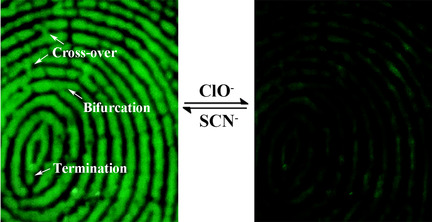
Safe and secure: A hydrogel based on a luminescent TbIII–carboxymethyl cellulose complex was developed for the selective detection, protection, and storage of fingerprint information. The imaging information could be quenched with ClO− ions and recovered by the addition of SCN−, thus leading to reversible on/off switching of the luminescence signal for fingerprint information encryption and decryption.
Heterogeneous Catalysis
Hydroxyl-Mediated Non-oxidative Propane Dehydrogenation over VOx/γ-Al2O3 Catalysts with Improved Stability
- Pages: 6791-6795
- First Published: 08 March 2018
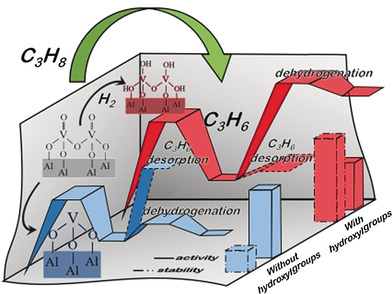
Lending support: The effect of surface hydroxyl groups, on supported vanadium catalysts, on the activity of propane dehydrogenation is studied. Although surface OH groups slightly suppress its dehydrogenation activity, the catalyst stability is increased. DFT calculations confirm that the existence of OH groups block the exposed V3+, on which there is a strong tendency to form coke.
Chemo-optogenetics
Tunable and Photoswitchable Chemically Induced Dimerization for Chemo-optogenetic Control of Protein and Organelle Positioning
- Pages: 6796-6799
- First Published: 10 April 2018
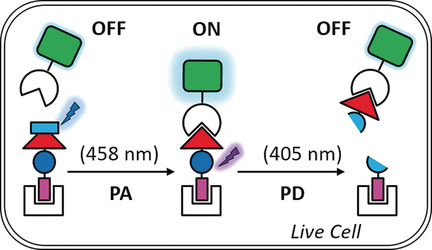
Guided by the light: Photoswitchable chemically induced dimerization (psCID), a chemo-optogenetic approach for controlling cellular function in a rapid and reversible manner, is presented. Using psCID, the degree of dimerization and dedimerization could be fine-tuned by applying different doses of illumination and the localization of proteins and positioning of organelles in living cells was controlled with high spatial and temporal precision.
Cell Surface Engineering
Polyvalent Display of Biomolecules on Live Cells
- Pages: 6800-6804
- First Published: 29 January 2018
Bioelectronics
Distinct Electron Conductance Regimes in Bacterial Decaheme Cytochromes
- Pages: 6805-6809
- First Published: 17 April 2018

How many electrons? Decaheme cytochromes function as electron conduits for extracellular electron transport in Shewanella oneidensis MR-1. Calculations suggest that redox potentials of the hemes depend on the number of electrons flowing through the system, and that different regimes are operational at different environments or conditions (in vivo, or when the cytochrome is isolated in solution or bound to the electrodes).
Enzyme Mechanisms
Molecular Insight into the Mg2+-Dependent Allosteric Control of Indole Prenylation by Aromatic Prenyltransferase AmbP1
- Pages: 6810-6813
- First Published: 20 April 2018

Crystal clear: High-resolution crystal structures were obtained for ternary complexes of the prenyltransferase AmbP1 with geranyl cis-indolyl vinyl isonitrile and geranyl S-thiodiphosphate. Comparison of the structures obtained in the presence and absence of Mg2+ provides mechanistic insight into Mg2+-dependent allosteric control of regiospecificity in prenyltransferases.
Membranes
A Regularly Channeled Lamellar Membrane for Unparalleled Water and Organics Permeation
- Pages: 6814-6818
- First Published: 06 March 2018
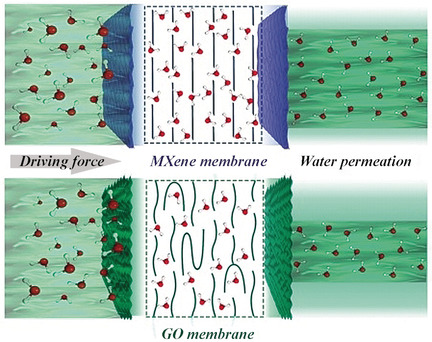
A lamellar membrane with regular, straight, and robust 2 nm interlayer channels are fabricated using double-layered Ti3C2Tx MXenes as rigid building blocks via a direct self-stacking. Such channels permit precise molecular rejection, and unparalleled permeation spanning from water to organics, which make them superior in comparison to those formed by flexible GO sheets.
Electrocatalysis
Versatile Three-Dimensional Porous Cu@Cu2O Aerogel Networks as Electrocatalysts and Mimicking Peroxidases
- Pages: 6819-6824
- First Published: 06 April 2018

A facile strategy to form 3D porous Cu@Cu2O aerogel networks by self-assembling Cu@Cu2O nanoparticles for constructing catalytic interfaces as electrocatalysts and mimicking peroxidases is reported. The 3D Cu@Cu2O aerogel networks exhibit excellent electrocatalysis ability toward glucose oxidation and peroxidase-like catalytic activity to the oxidation of a variety of substrates, including dopamine, in the presence of H2O2.
Lithium Batteries
Free-Standing Air Cathodes Based on 3D Hierarchically Porous Carbon Membranes: Kinetic Overpotential of Continuous Macropores in Li-O2 Batteries
- Pages: 6825-6829
- First Published: 03 May 2018
Biosynthesis
De novo Biosynthesis of “Non-Natural” Thaxtomin Phytotoxins
- Pages: 6830-6833
- First Published: 30 March 2018
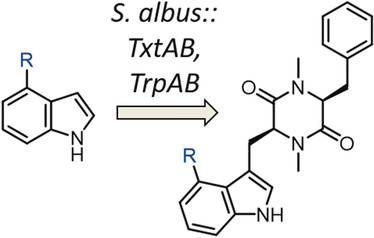
Feeding indoles: Thaxtomins are phytotoxins with potent bioactivity and a novel mode of action. The thaxtomin NRPS from S. scabies, along with genes encoding tryptophan synthase (TrpS), from Salmonella typhimurium, were assembled in a S. albus heterologous host. Feeding indole analogues to this host allowed the biosynthesis of a series of thaxtomin derivatives in a single fermentation from commercially available indole starting materials.
Nanocomposites | Very Important Paper
Silica-Protection-Assisted Encapsulation of Cu2O Nanocubes into a Metal–Organic Framework (ZIF-8) To Provide a Composite Catalyst
- Pages: 6834-6837
- First Published: 08 March 2018
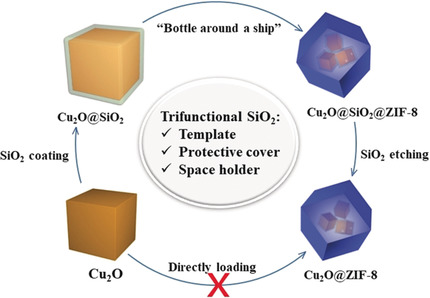
Three birds with one stone: A template protection–sacrifice method was developed to encapsulate metastable metal/metal oxide nanoparticles such as Cu2O into metal–organic frameworks. SiO2 serves as a sacrificial template for forming the yolk–shell structure, as a protective shell for Cu2O nanocubes, and as a space holder in the porous composite.
Nanomotors
Noncontinuous Super-Diffusive Dynamics of a Light-Activated Nanobottle Motor
- Pages: 6838-6842
- First Published: 03 April 2018
Supramolecular Chemistry | Hot Paper
Supramolecular Copolymerization as a Strategy to Control the Stability of Self-Assembled Nanofibers
- Pages: 6843-6847
- First Published: 02 May 2018
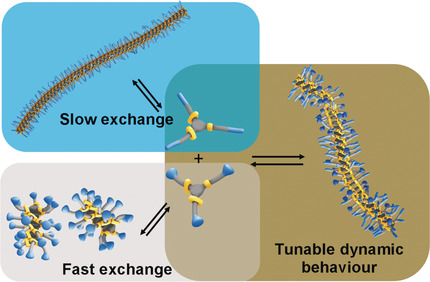
The exchange dynamics of supramolecular polymers based on benzene-1,3,5-tricarboxamide (BTA) can be regulated by copolymerizing molecules with dendronized (dBTA) and linear (nBTA) ethylene glycol-based water-soluble side chains. Whereas nBTAs form long nanofibers in water, dBTAs do not polymerize. The copolymerization of the two BTAs results in more stable long nanofibers.
Polymer NMR Spectroscopy
Dynamic Nuclear Polarization NMR Spectroscopy of Polymeric Carbon Nitride Photocatalysts: Insights into Structural Defects and Reactivity
- Pages: 6848-6852
- First Published: 06 April 2018
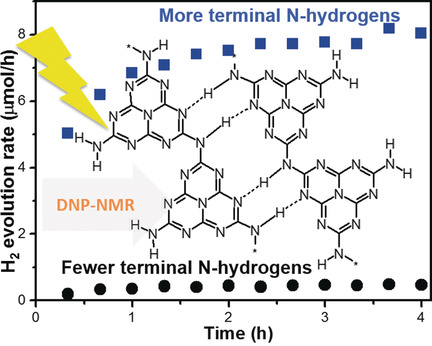
Generous to a fault: Structural defects in photocatalytic polymeric carbon nitrides are correlated with photocatalyzed hydrogen evolution. An increased number of terminal N−H bonds (▪(blue)) and reduced hydrogen bonding is associated with high performance, whereas polymer containing fewer terminal N−H bonds (•) solicits lower performance.
Hydrostannation
Regioselective Formation of (E)-β-Vinylstannanes with a Topologically Controlled Molybdenum-Based Alkyne Hydrostannation Catalyst
- Pages: 6853-6857
- First Published: 16 April 2018
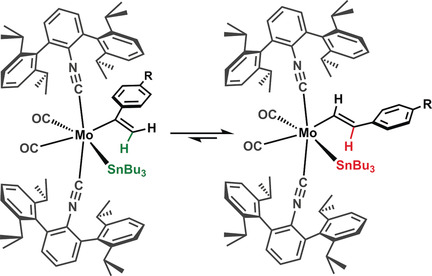
Opposite sides: Alkyne hydrostannation catalysts are traditionally effective at providing 1,1-vinylstannanes (α-products), with the selective delivery of E-configured 1,2-vinylstannanes ((E)-β-products) being much more challenging. Reported here is a molybdenum/isocyanide-based catalyst that overcomes this difficulty with high regioselectivity.
Carbonylation
Direct Access to Aryl Bis(trifluoromethyl)carbinols from Aryl Bromides or Fluorosulfates: Palladium-Catalyzed Carbonylation
- Pages: 6858-6862
- First Published: 17 April 2018

The more the merrier: Described is the direct synthesis of aryl bis(trifluoromethyl)carbinols from aryl bromides and fluorosulfates with a stoichiometric amount of carbon monoxide and two equivalents of trifluoromethyltrimethylsilane. The method exhibits good yields, broad scope, and good functional-group tolerance, and is suitable for carbon-isotope labeling.
Biocatalysis
Synthesis of Vibegron Enabled by a Ketoreductase Rationally Designed for High pH Dynamic Kinetic Reduction
- Pages: 6863-6867
- First Published: 24 April 2018

Evolution for synthetic efficiency: Target-driven evolution optimizes enzymes for synthetically desired transformations under conditions that challenge and surpass known limitations of enzyme performance. A biocatalyst that was engineered for stereoselective, dynamic kinetic reduction in a high-pH environment has enabled an efficient synthesis of vibegron, a potent β3-adrenergic agonist for the treatment of overactive bladder syndrome.
Aptamers
Crowding Shifts the FMN Recognition Mechanism of Riboswitch Aptamer from Conformational Selection to Induced Fit
- Pages: 6868-6872
- First Published: 16 April 2018
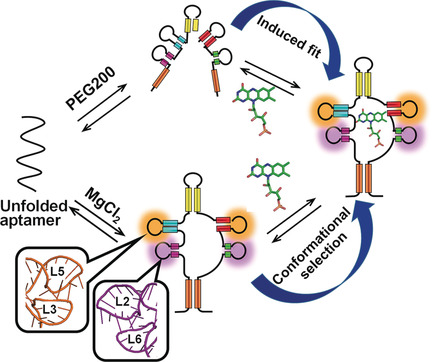
How the FMN riboswitch aptamer recognizes anionic FMN in the presence of molecular crowding agent without Mg2+ ion, which mimics conditions in pathogenic bacterial cells, was investigated. Structural, kinetic, and thermodynamic analyses under crowding conditions reveal that FMN binding occurs through an induced fit mechanism. This is in contrast to the known conformational selection mechanism that occurs in the presence of Mg2+.
Chiral MOFs | Very Important Paper
Ultrathin Chiral Metal–Organic-Framework Nanosheets for Efficient Enantioselective Separation
- Pages: 6873-6877
- First Published: 17 April 2018

Think thin: Ultrathin chiral metal–organic framework (CMOF) nanosheets of only few layers in thickness are prepared for the first time by a biomimetic strategy. Benefiting from the much larger number of exposed chiral sites, ultrathin CMOF nanosheets exhibit far superior enantioselectivity in chiral separation than their bulk counterparts.
Phase Transitions
Genetically Engineered Supercharged Polypeptide Fluids: Fast and Persistent Self-Ordering Induced by Touch
- Pages: 6878-6882
- First Published: 16 April 2018
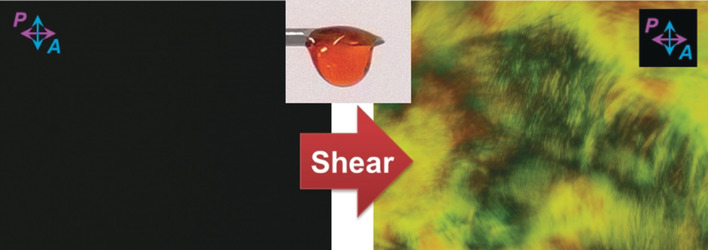
Stimuli-responsive protein fluids: A type of bio-based fluid exhibiting shear-induced phase transitions has been generated by electrostatic complexation of supercharged polypeptides with aromatic surfactants. This sensitive, fast, and persistent self-ordering behavior was exploited for water flow detection and capturing of fingerprint information by easily recordable birefringence.
Electrocatalysis
Catholyte-Free Electrocatalytic CO2 Reduction to Formate
- Pages: 6883-6887
- First Published: 16 April 2018
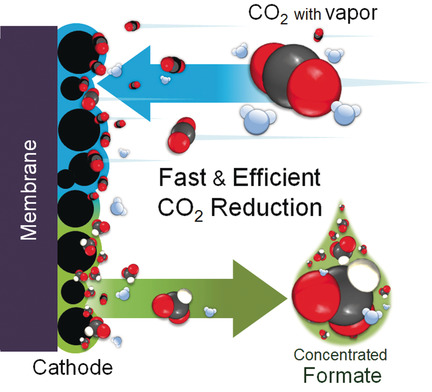
Fast and efficient CO2 reduction: A facile strategy of catholyte-free electrocatalytic CO2 reduction (CF-CO2R) for formate production is proposed to avoid a solubility limitation in an aqueous electrolyte. The CF-CO2R method provides an increased CO2 transfer rate to the electrocatalyst and showed a significantly high formate concentration at a high current density with a high Faradaic efficiency for formate production at a low cell voltage.
Indole Alkaloids
Development of the Vinylogous Pictet–Spengler Cyclization and Total Synthesis of (±)-Lundurine A
- Pages: 6888-6891
- First Published: 16 April 2018

Not just a happy medium: A vinylogous Pictet–Spengler cyclization has been developed for the generation of indole-annulated medium-sized rings. The method enables the synthesis of tetrahydroazocinoindoles with a fully substituted carbon center, a structural motif that is prevalent in biologically active alkaloids. The strategy has been applied to the total synthesis of (±)-lundurine A (see scheme).
DNA Nanotechnology | Hot Paper
Universal pH-Responsive and Metal-Ion-Free Self-Assembly of DNA Nanostructures
- Pages: 6892-6895
- First Published: 23 April 2018
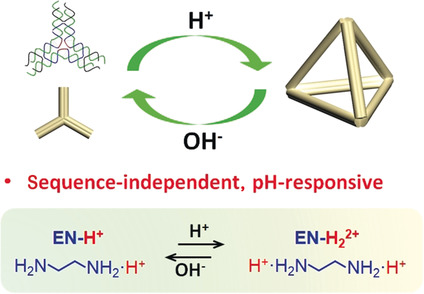
ENabled: Utilizing ethylenediamine (EN) as a substitute for metal cations leads to a universal pH regulation strategy for DNA self-assembly. The approach not only provides a general, sequence-independent, pH-responsive platform for dynamic DNA nanotechnology, but also endows DNA self-assembly with the benefits from a metal-ion-free environment.
Synthetic Methods
Catalytic Direct-Type Addition Reactions of Alkylarenes with Imines and Alkenes
- Pages: 6896-6900
- First Published: 16 April 2018

Going strong: Catalytic addition reactions of very weakly acidic nonactivated alkylarenes such as toluene and its derivatives were developed by using a strongly basic mixed catalyst system under mild reaction conditions. Addition reactions with imines and alkenes proceeded smoothly under proton-transfer conditions to afford the desired products in good to high yields. An asymmetric addition reaction of an alkylarene was also found to be possible.
Biomass-Derived Fine Chemicals
Synthesis of 1,4-Cyclohexanedimethanol, 1,4-Cyclohexanedicarboxylic Acid and 1,2-Cyclohexanedicarboxylates from Formaldehyde, Crotonaldehyde and Acrylate/Fumarate
- Pages: 6901-6905
- First Published: 19 April 2018
Homogeneous Catalysis
Efficient CO2 Insertion and Reduction Catalyzed by a Terminal Zinc Hydride Complex
- Pages: 6906-6909
- First Published: 16 April 2018
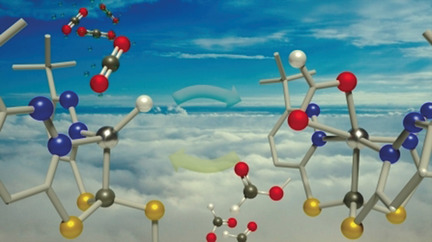
CO2 inside the hydride: The terminal zinc hydride complex [Tntm]ZnH, based on the electron-deficient tris(6-tert-butyl-3-thiopyridazinyl)methanide ligand, is an excellent catalyst for the hydrosilylation of CO2 at room temperature, forming exclusively the respective silyl formate. This fast reaction is attributed to the electron-deficient properties of the [Tntm] ligand in combination with its flexible coordination.
Carboxylation | Hot Paper
A General, Activator-Free Palladium-Catalyzed Synthesis of Arylacetic and Benzoic Acids from Formic Acid
- Pages: 6910-6914
- First Published: 16 April 2018
Gold Redox Catalysis
Highly Efficient and Stereoselective Thioallylation of Alkynes: Possible Gold Redox Catalysis with No Need for a Strong Oxidant
- Pages: 6915-6920
- First Published: 07 May 2018

Gentle as an ox: A broad range of alkynes underwent gold-catalyzed stereoselective thioallylation with high efficiency (low catalyst loading, high yields). The gold(I) catalyst acts as both a π-acid for alkyne activation and a redox catalyst for AuI/III coupling, while the sulfonium cation generated in situ functions as a mild oxidant (see scheme).
Fluoroalkylation
Bulky Diamine Ligand Promotes Cross-Coupling of Difluoroalkyl Bromides by Iron Catalysis
- Pages: 6921-6925
- First Published: 17 April 2018

Ligand design: An iron-catalyzed cross-coupling between arylmagnesium bromides and difluoroalkyl bromides, with modified N,N,N′,N′-tetramethyl-ethane-1,2-diamine (TMEDA) as a ligand, is described. The combination of iron(II) salts with L enables the difluoroalkylations with a wide range of difluoroalkyl bromides, thus providing general and cost-efficient access to difluoroalkylated arenes that are of great interest in the life sciences.
Photoredox Catalysis
Trifluoromethanesulfonic Anhydride as a Low-Cost and Versatile Trifluoromethylation Reagent
- Pages: 6926-6929
- First Published: 19 April 2018

The light FFFantastic: An unprecedented application of trifluoromethanesulfonic anhydride as a radical trifluoromethylation reagent was developed by merging photoredox catalysis and pyridine activation. The synthetic utility of this method is exemplified by the C−H trifluoromethylation of (hetero)arenes and trifluoromethyltriflation of alkynes.
Supramolecular Chemistry
Electronic Communication between two [10]cycloparaphenylenes and Bis(azafullerene) (C59N)2 Induced by Cooperative Complexation
- Pages: 6930-6934
- First Published: 23 March 2018
![Electronic Communication between two [10]cycloparaphenylenes and Bis(azafullerene) (C59N)2 Induced by Cooperative Complexation](/cms/asset/6d3e4a0d-b6c5-422e-b6d8-62a16a584659/anie201713197-toc-0001-m.jpg)
Communications skills: The photophysical and redox properties of the complex of two [10]cycloparaphenylenes ([10]CPPs) with bis(azafullerene) (C59N)2 support an electronic interaction between the components. This supramolecular organic fullerene assembly demonstrates C60-like ground-state properties and metallofullerene-like excited-state properties opening new avenues for organic materials.
Ring Expansion
Gold-Catalyzed Regiospecific C−H Annulation of o-Ethynylbiaryls with Anthranils: π-Extension by Ring-Expansion En Route to N-Doped PAHs
- Pages: 6935-6939
- First Published: 06 April 2018

Good as gold: A gold-catalyzed π-extension of anthranils with o-ethynylbiaryls as reagents was developed that provides a novel, short, and flexible approach to diverse N-doped polycyclic aromatic hydrocarbons (PAHs). The mechanism is proposed to involve a nucleophilic addition/ring opening/regiospecific C−H annulation/protodeauration sequence terminated by a Friedel–Crafts-type cyclization.
Ring-Closing Metathesis | Hot Paper
Iron-Catalyzed Ring-Closing C−O/C−O Metathesis of Aliphatic Ethers
- Pages: 6940-6944
- First Published: 30 March 2018




